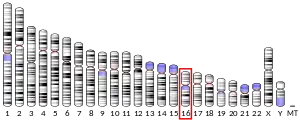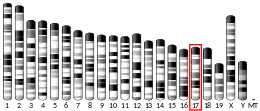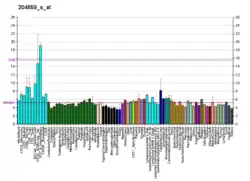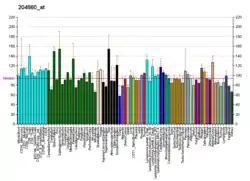| GFER | |||||||||||||||||||||||||||||||||||||||||||||||||||
|---|---|---|---|---|---|---|---|---|---|---|---|---|---|---|---|---|---|---|---|---|---|---|---|---|---|---|---|---|---|---|---|---|---|---|---|---|---|---|---|---|---|---|---|---|---|---|---|---|---|---|---|
| |||||||||||||||||||||||||||||||||||||||||||||||||||
| Identifiers | |||||||||||||||||||||||||||||||||||||||||||||||||||
| Aliases | GFER, ALR, ERV1, HERV1, HPO, HPO1, HPO2, HSS, growth factor, augmenter of liver regeneration, MMCHD, MPMCD | ||||||||||||||||||||||||||||||||||||||||||||||||||
| External IDs | OMIM: 600924 MGI: 107757 HomoloGene: 55884 GeneCards: GFER | ||||||||||||||||||||||||||||||||||||||||||||||||||
| |||||||||||||||||||||||||||||||||||||||||||||||||||
| |||||||||||||||||||||||||||||||||||||||||||||||||||
| |||||||||||||||||||||||||||||||||||||||||||||||||||
| |||||||||||||||||||||||||||||||||||||||||||||||||||
| |||||||||||||||||||||||||||||||||||||||||||||||||||
| Wikidata | |||||||||||||||||||||||||||||||||||||||||||||||||||
| |||||||||||||||||||||||||||||||||||||||||||||||||||
Growth factor, augmenter of liver regeneration (ERV1 homolog, S. cerevisiae), also known as GFER, or Hepatopoietin is a protein which in humans is encoded by the GFER gene. This gene is also known as essential for respiration and vegatative growth, augmenter of liver regeneration, and growth factor of Erv1-like/Hepatic regenerative stimulation substance.[5][6][7]
Structure
The GFER gene is located on the p arm of chromosome 16 at position 13.3 and it spans 3,600 base pairs.[5] The GFER gene produces a 15.4 kDa protein composed of 130 amino acids.[8][9] The structure of the protein is a homodimer which has been found to be fairly similar to the scERV1 protein of yeast.[10]
Genomics
The gene resides on chromosome 16 in the interval containing the locus for polycystic kidney disease (PKD1). The putative gene product is 42% similar to the scERV1 protein of yeast. The human gene has three exons: the first encodes a 5' untranslated region and the first part of the protein; the second encodes the bulk of the protein; and the third the remainder.
Molecular biology
Proteins of the ERV1/ALR family are encoded by all eukaryotes and cytoplasmic DNA viruses for which the sequence data are available. All possess a C-X-X-C motif within a ~100 amino acid domain
Function
The hepatotrophic factor designated augmenter of liver regeneration (ALR) is thought to be one of the factors responsible for the extraordinary regenerative capacity of mammalian liver. It has also been called hepatic regenerative stimulation substance (HSS). The yeast scERV1 gene had been found to be essential for oxidative phosphorylation, the maintenance of mitochondrial genomes, and the cell division cycle. The human gene is both the structural and functional homolog of the yeast scERV1 gene.[5]
This protein interacts with Mia40 during the import of intermembrane space proteins including the small Tim proteins Cox17 and Cox19 both of which have disulfide bonds.
Clinical Significance
Mutations in GFER has been shown to result in Myopathy, mitochondrial progressive, with congenital cataract, hearing loss and developmental delay (MPMCHD). MPMCHD is a disease characterized by progressive myopathy and partial combined respiratory-chain deficiency, congenital cataract, sensorineural hearing loss, and developmental delay.
Interactions
GFER has been shown to interact with COP9 constitutive photomorphogenic homolog subunit 5[11] and BNIPL.[12]
References
- 1 2 3 GRCh38: Ensembl release 89: ENSG00000127554 - Ensembl, May 2017
- 1 2 3 GRCm38: Ensembl release 89: ENSMUSG00000040888 - Ensembl, May 2017
- ↑ "Human PubMed Reference:". National Center for Biotechnology Information, U.S. National Library of Medicine.
- ↑ "Mouse PubMed Reference:". National Center for Biotechnology Information, U.S. National Library of Medicine.
- 1 2 3 "Entrez Gene: GFER growth factor, augmenter of liver regeneration (ERV1 homolog, S. cerevisiae)".
- ↑
"GFER - FAD-linked sulfhydryl oxidase ALR - Homo sapiens (Human) - GFER gene & protein". Retrieved 2018-08-21.
 This article incorporates text available under the CC BY 4.0 license.
This article incorporates text available under the CC BY 4.0 license.
- ↑ "UniProt: the universal protein knowledgebase". Nucleic Acids Research. 45 (D1): D158–D169. January 2017. doi:10.1093/nar/gkw1099. PMC 5210571. PMID 27899622.
- ↑ Zong NC, Li H, Li H, Lam MP, Jimenez RC, Kim CS, Deng N, Kim AK, Choi JH, Zelaya I, Liem D, Meyer D, Odeberg J, Fang C, Lu HJ, Xu T, Weiss J, Duan H, Uhlen M, Yates JR, Apweiler R, Ge J, Hermjakob H, Ping P (October 2013). "Integration of cardiac proteome biology and medicine by a specialized knowledgebase". Circulation Research. 113 (9): 1043–53. doi:10.1161/CIRCRESAHA.113.301151. PMC 4076475. PMID 23965338.
- ↑ "GFER-Sulfhydryl oxidase". Cardiac Organellar Protein Atlas Knowledgebase (COPaKB). Archived from the original on 2018-08-21. Retrieved 2018-08-21.
- ↑ Lisowsky T, Weinstat-Saslow DL, Barton N, Reeders ST, Schneider MC (October 1995). "A new human gene located in the PKD1 region of chromosome 16 is a functional homologue to ERV1 of yeast". Genomics. 29 (3): 690–7. doi:10.1006/geno.1995.9950. PMID 8575761.
- ↑ Lu C, Li Y, Zhao Y, Xing G, Tang F, Wang Q, Sun Y, Wei H, Yang X, Wu C, Chen J, Guan KL, Zhang C, Chen H, He F (January 2002). "Intracrine hepatopoietin potentiates AP-1 activity through JAB1 independent of MAPK pathway". FASEB Journal. 16 (1): 90–2. doi:10.1096/fj.01-0506fje. PMID 11709497. S2CID 7006611.
- ↑ Shen L, Hu J, Lu H, Wu M, Qin W, Wan D, Li YY, Gu J (April 2003). "The apoptosis-associated protein BNIPL interacts with two cell proliferation-related proteins, MIF and GFER". FEBS Letters. 540 (1–3): 86–90. doi:10.1016/S0014-5793(03)00229-1. PMID 12681488. S2CID 9977125.
Further reading
- Francavilla A, Hagiya M, Porter KA, Polimeno L, Ihara I, Starzl TE (September 1994). "Augmenter of liver regeneration: its place in the universe of hepatic growth factors" (PDF). Hepatology. 20 (3): 747–57. doi:10.1002/hep.1840200328. PMID 8076931. S2CID 9802779.
- Gatzidou, Elisavet (2006-08-21). "Insights on augmenter of liver regeneration cloning and function". World Journal of Gastroenterology. 12 (31): 4951–8. doi:10.3748/wjg.v12.i31.4951. ISSN 1007-9327. PMC 4087396. PMID 16937489.
- Lisowsky T (March 1992). "Dual function of a new nuclear gene for oxidative phosphorylation and vegetative growth in yeast". Molecular & General Genetics. 232 (1): 58–64. doi:10.1007/BF00299137. PMID 1552903. S2CID 27133342.
- Renan MJ, Reeves BR (1987). "Chromosomal localization of human endogenous retroviral element ERV1 to 18q22----q23 by in situ hybridization". Cytogenetics and Cell Genetics. 44 (2–3): 167–70. doi:10.1159/000132365. PMID 3568764.
- O'Brien SJ, Bonner TI, Cohen M, O'Connell C, Nash WG (1983). "Mapping of an endogenous retroviral sequence to human chromosome 18". Nature. 303 (5912): 74–7. Bibcode:1983Natur.303...74O. doi:10.1038/303074a0. PMID 6843662. S2CID 4267099.
- Giorda R, Hagiya M, Seki T, Shimonishi M, Sakai H, Michaelson J, Francavilla A, Starzl TE, Trucco M (January 1996). "Analysis of the structure and expression of the augmenter of liver regeneration (ALR) gene". Molecular Medicine. 2 (1): 97–108. doi:10.1007/BF03402206. PMC 2230030. PMID 8900538.
- Yang XM, Hu ZY, Xie L, Wu ZZ, Wu CT, He FC (October 1997). "[In vitro stimulation of HTC hepatoma cell growth by recombinant human augmenter of liver regeneration (ALR)]". Sheng Li Xue Bao. 49 (5): 557–61. PMID 9813496.
- Wang G, Yang X, Zhang Y, Wang Q, Chen H, Wei H, Xing G, Xie L, Hu Z, Zhang C, Fang D, Wu C, He F (April 1999). "Identification and characterization of receptor for mammalian hepatopoietin that is homologous to yeast ERV1". The Journal of Biological Chemistry. 274 (17): 11469–72. doi:10.1074/jbc.274.17.11469. PMID 10206950.
- Hofhaus G, Stein G, Polimeno L, Francavilla A, Lisowsky T (May 1999). "Highly divergent amino termini of the homologous human ALR and yeast scERV1 gene products define species specific differences in cellular localization". European Journal of Cell Biology. 78 (5): 349–56. doi:10.1016/S0171-9335(99)80069-7. PMID 10384986.
- Li Y, Li M, Xing G, Hu Z, Wang Q, Dong C, Wei H, Fan G, Chen J, Yang X, Zhao S, Chen H, Guan K, Wu C, Zhang C, He F (December 2000). "Stimulation of the mitogen-activated protein kinase cascade and tyrosine phosphorylation of the epidermal growth factor receptor by hepatopoietin". The Journal of Biological Chemistry. 275 (48): 37443–7. doi:10.1074/jbc.M004373200. PMID 10982794.
- Lu C, Li Y, Zhao Y, Xing G, Tang F, Wang Q, Sun Y, Wei H, Yang X, Wu C, Chen J, Guan KL, Zhang C, Chen H, He F (January 2002). "Intracrine hepatopoietin potentiates AP-1 activity through JAB1 independent of MAPK pathway". FASEB Journal. 16 (1): 90–2. doi:10.1096/fj.01-0506fje. PMID 11709497. S2CID 7006611.
- Cheng J, Zhong YW, Liu Y, Dong J, Yang JZ, Chen JM (April 2000). "Cloning and sequence analysis of human genomic DNA of augmenter of liver regeneration". World Journal of Gastroenterology. 6 (2): 275–277. doi:10.3748/wjg.v6.i2.275 (inactive 1 August 2023). PMC 4723503. PMID 11819575.
{{cite journal}}: CS1 maint: DOI inactive as of August 2023 (link) - Li Y, Xing G, Wang Q, Li M, Wei H, Fan G, Chen J, Yang X, Wu C, Chen H, He F (December 2001). "Hepatopoietin acts as an autocrine growth factor in hepatoma cells". DNA and Cell Biology. 20 (12): 791–5. doi:10.1089/104454901753438606. PMID 11879572.
- Lu J, Xu WX, Zhan YQ, Cui XL, Cai WM, He FC, Yang XM (April 2002). "Identification and characterization of a novel isoform of hepatopoietin". World Journal of Gastroenterology. 8 (2): 353–6. doi:10.3748/wjg.v8.i2.353. PMC 4658383. PMID 11925624.
- Li Y, Wei K, Lu C, Li Y, Li M, Xing G, Wei H, Wang Q, Chen J, Wu C, Chen H, Yang S, He F (August 2002). "Identification of hepatopoietin dimerization, its interacting regions and alternative splicing of its transcription". European Journal of Biochemistry. 269 (16): 3888–93. doi:10.1046/j.1432-1033.2002.03054.x. PMID 12180965.
- Zhao Y, Tang F, Cheng J, Li L, Xing G, Zhu Y, Zhang L, Wei H, He F (April 2003). "An initiator and its flanking elements function as a core promoter driving transcription of the Hepatopoietin gene". FEBS Letters. 540 (1–3): 58–64. doi:10.1016/S0014-5793(03)00158-3. PMID 12681483. S2CID 30314058.
- Shen L, Hu J, Lu H, Wu M, Qin W, Wan D, Li YY, Gu J (April 2003). "The apoptosis-associated protein BNIPL interacts with two cell proliferation-related proteins, MIF and GFER". FEBS Letters. 540 (1–3): 86–90. doi:10.1016/S0014-5793(03)00229-1. PMID 12681488. S2CID 9977125.





